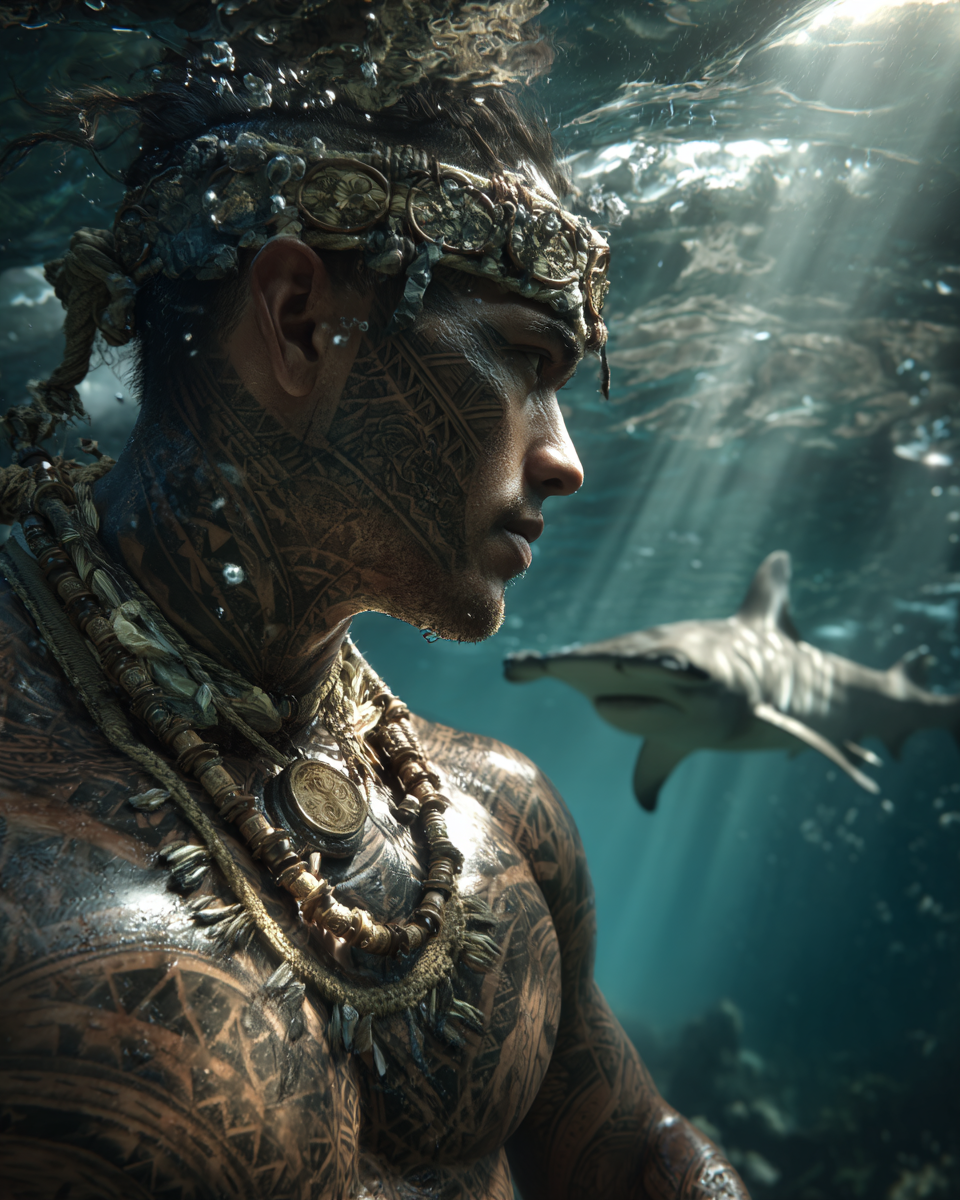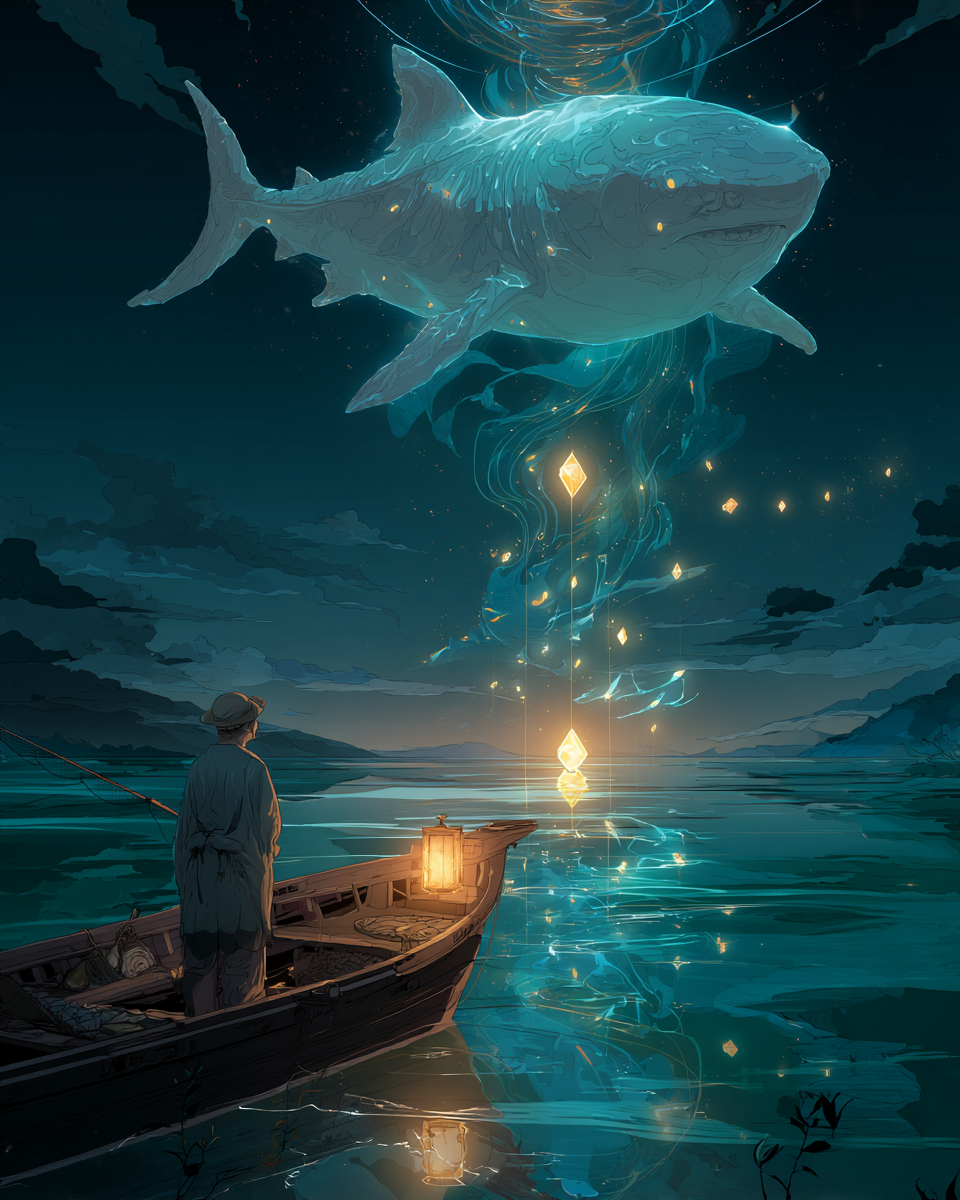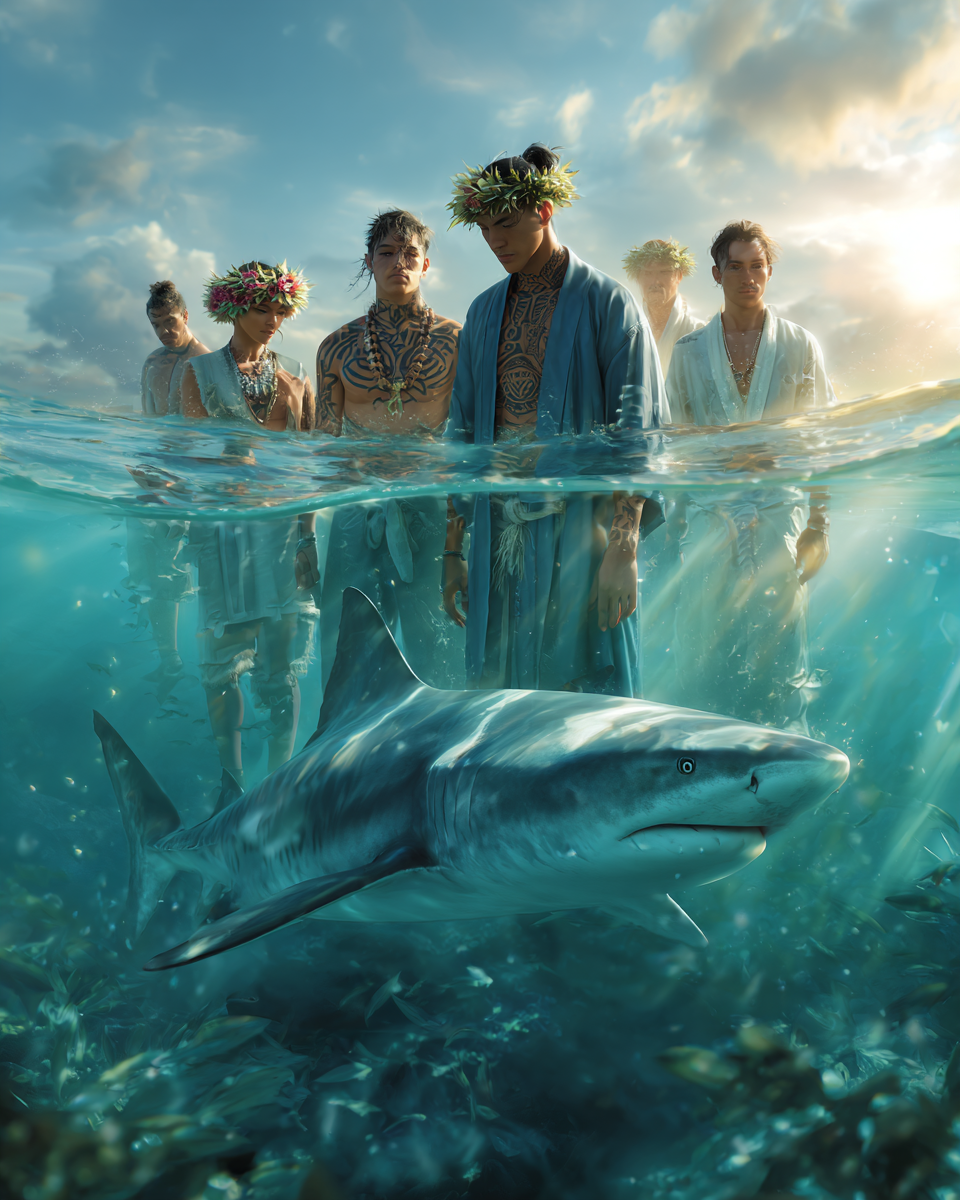Sharks and Culture
- Jana Gombošová

- Aug 18
- 8 min read
Not every culture sees sharks as dangerous monsters. This image emerged mainly in Western civilization. These remarkable predators have also been perceived as deities, guardians, or even embodiments of ancestors—from the Hawaiian ‘aumākua, to Māori warriors, to Japanese legends. Thanks to scientists, filmmakers, and conservationists, we too are learning to see sharks the way those who know the ocean best have always seen them.
Hawaii and Polynesia
In Polynesian cultures, from Hawaii to Tahiti, the shark is not seen as a cruel predator—it is considered part of the community, often even sacred. Many local families believe that certain ancestors transform into sharks after death, becoming aumākua—ancestral guardian spirits of the family.
In traditional Hawaiian spirituality, an aumākua is a family guardian spirit that can take many forms: a bird, a turtle, a moray eel—but one of the most common forms is the shark (manō). This spirit protects family members from danger, especially at sea. Some families believed that a shark could recognize its “own” and, if someone was drowning, the aumākua would save them. Killing a shark—especially one recognized as an aumākua—was strictly taboo and believed to bring misfortune.

Hawaiians associated their spiritual shark with specific traits: unusual markings passed down through generations, a scar or deformity on a fin, or distinctive behavior—such as staying close to the canoe only when family members were on board. Out of respect, some families would feed the shark or throw part of their catch back into the sea as a gesture of gratitude for its protection. In Hawaiian tradition, the sacred shark is most often linked to the tiger shark (Galeocerdo cuvier). This species is commonly found near the shore, where daily fishing rituals took place, and it stood out with its striking appearance, majestic strength, and ability to survive in diverse conditions.
In traditional mele (chants) and hula dances, sharks as aumākua were often invoked. These songs were performed before sea voyages, at the birth of a child, as a plea for protection, or during Makahiki—the harvest and peace festival that also honored the ancestors. This shows that the shark aumākua was not just a mythological figure, but a living part of everyday spiritual practice.
On the island of Moloka‘i, a story is still told about a shark named Kāne‘aukai. He was known as an aumākua who rescued shipwreck survivors, carrying them on his back all the way to shore, and after his death, locals built a stone shrine near the beach in his honor. People believed that if someone failed to acknowledge or respect their aumākua, the shark would not help them—maintaining that relationship of respect was essential.
In contrast to the Western view, where the shark is separated from “civilization” and labeled a threat, in Polynesian mythology it is part of genealogy (ancestors ≠ only humans), holds spiritual value, and is treated with reverence rather than fear. Today, many Hawaiians are striving to revive respect for the aumākua while also pointing out how mass fishing and finning are destroying not only ecosystems but also their cultural heritage.
Māori – New Zealand
For the Māori, the Indigenous people of Aotearoa (modern-day New Zealand), the shark was not just a sea creature but a symbol of power, leadership, and spiritual protection. In their traditional society—where strength, honor, and connection to ancestors were expressed through symbolism and tattooing—the shark (mangō) held a special place.
The most famous shark symbol in Māori culture is the mangō pare—a stylized design resembling the head of a hammerhead shark. This motif appeared in traditional tattooing (ta moko), in wood carvings on houses, canoes, and weapons (whakairo), as well as in amulets and ornaments worn around the neck.

The mangō pare symbolizes resilience, determination, and victory over obstacles. In battle, it was a sign that the wearer would never give up—that they would fight until the very end. This symbol was often associated with chiefs and important leaders (rangatira), who carried mana—spiritual power, respect, and authority. Unlike other traditional animals, such as the kiwi or the tuatara, the shark was valued primarily for its warrior qualities. Sharp shark teeth were used as tools and ornaments, jaws became part of ceremonial objects, and both teeth and bones were incorporated into weapons like the short clubs (mere). In some hapū (clans), specific shark species were regarded as sacred.
The Māori are part of the wider Polynesian cultural family, masters of navigation by stars, winds, and the behavior of animals. Sharks were also seen as signs of direction or the nearness of land, as guides for canoes, and sometimes even as messengers of ancestors—especially if they appeared unexpectedly. Local stories tell of sharks leading Māori canoes across the open sea or protecting them during fishing.
In Māori belief, there is the concept of kaitiaki —a guardian, guide, or spirit of a place or lineage. In some cases, this guardian took the form of a shark, protecting a specific community, sea, or territory. Unlike in Hollywood stories, the shark in traditional Māori culture was seen as a keeper of balance, not as a threat.
Japan
In traditional Japanese culture, the shark appears in several symbolic layers—as a mythical being, a protector, and even a bearer of sensitivity. One of the most striking figures in Japanese folklore is the Samebito—a shark-like demon with human features who appears in the legend The Gratitude of the Samebito. He is not a beast, but a tragic and sensitive being—an exile from the spirit world, living on land in sorrow and loneliness. His tears turn into precious jewels, and this is where the power of the story lies: the shark as an embodiment of otherness, empathy, and sensitivity, rather than threat.

In some coastal regions of Japan, the shark was regarded as a guardian of fishermen. Seeing a shark near the shore was interpreted as a sign of calm seas and safe waters. In other regions, however, it could be seen as a harbinger of misfortune or a punished spirit. This ambivalent view reflects the Japanese relationship with the ocean—one of deep respect, but also superstitious caution.
Interestingly, the shark also appeared in traditional Japanese theater, such as kabuki and noh. In these performances, it symbolized the darkness of the ocean, the unconscious, or a force beyond human control. It was not a specific character, but rather a metaphor—placing the shark among the spiritual symbols that hold a special place in Japanese culture.
In Japan, sharks have had—and unfortunately still have—a practical use. Although Japan is not among the largest consumers of shark fin soup, certain ports, such as Kesennuma, have become global hubs for shark processing. The industry in Kesennuma began at the turn of the 19th and 20th centuries, and today the port is the country’s main landing and processing site for sharks.
Most shark catches from across Japan end up here, with part of the production, including fins, exported to the international market. The meat, skin, cartilage, and liver oil are used primarily in food products and dietary supplements, and in some regions, shark meat is processed into a traditional dried snack known as same jerky.
In modern Japan, the shark has sadly shifted from the realm of spirits and symbols into that of industry and commerce. Yet, in literature, art, and local folklore, it has managed to retain a place that reflects an older, deeper perspective—that sharks are part of the ocean not only physically, but also spiritually.
The Western world
The relationship of Western civilization to sharks developed very differently from that of traditional cultures. While in Polynesia, New Zealand, or Japan the shark held deep spiritual meaning, in Europe and North America it was more often seen as a mysterious or dangerous creature. In 19th- and early 20th-century literature (for example, in the works of Jules Verne), sharks appeared as part of an exotic, unexplored world—but rarely as central figures. The real turning point came in the second half of the 20th century.
In 1975, Steven Spielberg released Jaws, a film that profoundly shaped how sharks are perceived to this day. The movie was based on the novel by Peter Benchley, itself inspired by a series of shark attacks off the coast of New Jersey in 1916. Benchley later admitted that much of the story was fictional, and after witnessing the consequences of his work, he became an outspoken advocate for shark conservation.
Jaws triggered a massive wave of panic. The shark became a symbol of death, threat, and irrational fear. Across much of the world, trophy hunting and finning surged, and sharks began to be treated as pests to be eradicated. This phenomenon is often referred to in scientific literature as the “Jaws effect.” In some regions, populations of large shark species declined by more than 70%, dramatically disrupting marine ecosystems.

Among those involved in the making of Jaws were Australian underwater filmmakers Valerie and Ron Taylor. Valerie Taylor is regarded as a pioneer of underwater cinematography and shark research, and she was one of the first people ever to swim cage-free with a great white shark. Together with Ron, she filmed authentic footage of great whites for Jaws, unaware that it would become part of a work that so drastically altered public opinion.
When they saw with horror the powerful effect the film had on audiences, both began actively engaging in shark conservation campaigns. Valerie Taylor later openly admitted that she regretted taking part in the movie. Together, the Taylors went on to create films that portrayed sharks in a different light—as fascinating, intelligent, and vulnerable creatures.
Another turning point in reshaping public perception came with the Canadian documentary Sharkwater (2006), directed by filmmaker and activist Rob Stewart. The film shocked audiences worldwide with its footage of illegal fishing, finning, and the brutal treatment of sharks. At the same time, it highlighted their ecological importance as apex predators and their role in maintaining ocean balance. With this work, Stewart ignited a global conversation about the need to protect sharks and inspired a new generation of activists.
Gradually, others joined in this shift—most notably British naturalist and filmmaker David Attenborough, who in series such as Blue Planet II presented sharks as vital players in the marine ecosystem. His documentaries helped millions of viewers understand that sharks are not bloodthirsty monsters but key predators, without which the entire system would collapse. Equally important is the work of oceanographer Sylvia Earle, who has long warned about the devastating consequences of industrial overfishing and commercial finning.
Although shark horror movies (Sharknado, The Meg, and many others) continue to be produced, public perception is slowly evolving. Thanks to the efforts of scientists, filmmakers, and activists, a new generation has emerged—one that not only respects sharks but actively works to protect them. Today, we know that the loss of every apex predator means the loss of balance in the ocean—and we are slowly learning that respect must be stronger than fear.

Cultural memory is powerful. And even though at times it has worked against nature, it can change—especially when we begin to listen to those who have always had a deeper connection with it. It’s time to stop fearing the unknown and open ourselves to understanding. In every sense.
________________________________________________________________________
Sources used:
Attenborough, D. (2017). Blue Planet II [TV series].
Ashkenazi, M. (2003). Handbook of Japanese Mythology. Oxford University Press.
Benchley, P. (2001). Shark Trouble: True Stories About Sharks and the Sea. Random House.
Best, E. (1929). Fishing Methods and Devices of the Maori (Dominion Museum Bulletin No. 12). Dominion Museum.
Choy, L. L. (2003). Aumakua: The sacred guardians of Hawaiian families. Hawaiian Journal of History.
Ellis, R. (2003). The Empty Ocean. Island Press.
Foster, M. D. (2009). Pandemonium and Parade: Japanese Monsters and the Culture of Yōkai. University of California Press.
Handy, E. S. C., & Pukui, M. K. (1998). The Polynesian Family System in Kaʻū, Hawaiʻi. Mutual Publishing.
McCosker, J. E. (1995). The Jaws Effect. Oceanus Magazine.
Mead, H. M. (2003). Tikanga Māori: Living by Māori Values. Huia Publishers.
Sterling, E. P., & Summers, C. C. (1978). Sites of Oʻahu. Bishop Museum Press.
Stewart, R. (Director). (2006). Sharkwater [Documentary]. Rob Stewart Productions.
Taylor, V., & Taylor, R. (1971). Blue Water, White Death [Documentary film].
Playing with Sharks: The Valerie Taylor Story (2021) [Documentary film].
Te Ara – The Encyclopedia of New Zealand. (n.d.). Sharks – Te mangō, Māori carving, Moko (tattoo). Retrieved from https://teara.govt.nz
Titcomb, M. (1972). Native Use of Fish in Hawaii. University of Hawaii Press.
Yoda, H., & Alt, M. (2013). Yokai Attack!: The Japanese Monster Survival Guide. Tuttle Publishing.
Earle, S. (2009). The World Is Blue: How Our Fate and the Ocean’s Are One. National Geographic.




Comments